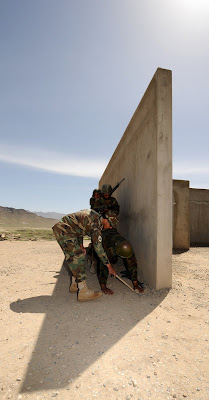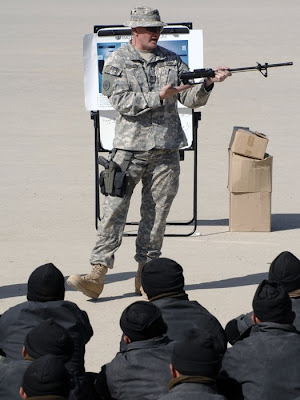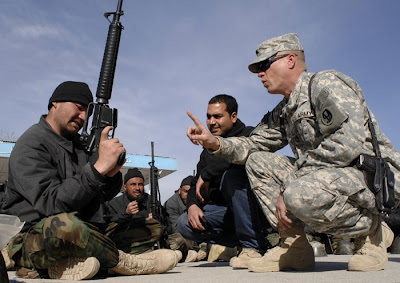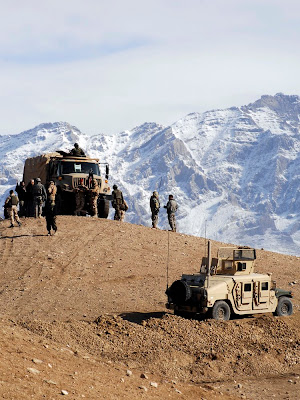Thursday, May 21, 2009
Day 373: A little extra never hurt anyone
Sunday, May 10, 2009
Day 362: ANA lead house-to-house training




Thursday, April 9, 2009
Day 331: Kuchi Village medical assistance mission



 Air Force Maj. Paul J. C. Valdez provides extra security during the mission to Kuchi Village. (Photo by G. A. Volb)
Air Force Maj. Paul J. C. Valdez provides extra security during the mission to Kuchi Village. (Photo by G. A. Volb)
Kuchi villagers welcome camp's medical assistance team
Five miles northeast of camp lays Kuchi Village, a rural community of nearly 1,000 who, in much need of medical attention, welcomed a coalition medical assistance visit April 5.
Arriving at the village, visitors are met with an atmosphere similar to that of a county fair --- makeshift accommodations, animals living in close proximity to the villagers, and the smell that comes when no waste disposal system is in place.
The villagers, however, seemed good hearted and open.
“I’m happy about this mission,” said Kuchi Village Malik Nungless as he looked out over the crowd of villagers who had gathered. “I’m happy because it was the coalition and Afghan national army that came to help us.”
The 72 year old sporting a thick, white beard appreciated the opportunity to receive free check ups and medicine. And it wasn’t the first time he welcomed these guests.
“We’ve visited the people of Kuchi Village on numerous occasions and they told us they had some medical issues,” said Sgt. 1st Class Aaron Christianson, a medical embedded training team NCO in charge assigned to Camp Alamo, originally from Effingham, Ill.
Christianson said during one of their previous visits they agreed to return and perform an on-site medical evaluation and treatment of the villagers. Afghan doctors and medics, both army and civilian, along with their U.S. counterparts, ensured 80 villagers were seen – to include women and children.
“We dispensed approximately 300 prescriptions, while referring nine patients to the local Cure Medical Hospital,” said Christianson. “Much of it was similar to what we’ve seen at other villages – muscular pain and various infectious diseases requiring antibiotic treatment.” The issues were, in many cases, due to their poor living conditions and lack of clean drinking water. In one particular case a 35-year-old man, who looked to be in his upper 40s, came into the makeshift medical tent wanting doctors to look at his lab and ultrasound results.
“There was nothing to indicate what preceded the ordering of the tests,” said Dr. (Air Force Lt. Col.) Scott Caulkins, a family practice physician normally assigned to Hurlburt Field, Fla. “He gave a history of edema and body aches. Labs showed signs of kidney disease with proteinuria and mildly elevated liver function studies, and negative hepatitis tests. Ultrasounds of the liver, gall bladder, pancreas, kidneys, and bladder only showed stones up in the kidney.
“As long as the stones stay in the kidney, he has a greater risk of being harmed in the process of getting them removed, but the proteinuria suggests other medical kidney disease,” said Caulkins, from Niceville, Fla. “We gave him a referral for an internal medicine evaluation at the Cure hospital downtown, and recommended increased hydration in general.”
Then there was 6-year-old Neamatullah who, only days earlier, had a run in with one of the many large dogs loitering throughout the village, leaving him with a sizeable chunk of his backside missing.
“The dog bit him four days ago,” said his father Ghundal. “Yet this was the second time the ANA and U.S. doctors have treated him.”
“It’s always a pleasure to get out and perform our real mission, helping the local Afghan people that are so desperately in need of medical care, making new friends, and exchanging cultural knowledge,” said Christianson. Camp Alamo’s commander agreed on the importance of such missions.
“Humanitarian assistance visits, such as this, are a key component of counter-insurgency operations,” said Army Lt. Col. Brian Redmon, Camp Alamo Mentor Group commander.
“The importance of this is demonstrated by the multi-national cooperation between the Afghan, U.K. and U.S. personnel to make this assistance mission a reality,” added the 44-year-old Redmon, a native of Springfield, Ill.
Sunday, March 8, 2009
Day 298: Welcome the M16


ANA Kandak receives first M-16s for field training
By G. A. Volb
Camp Alamo Public Affairs
CAMP ALAMO, Afghanistan – Afghan National Army recruit Mirza Budin, 24, sat with dozens of his fellow Kandak soldiers on the parade field, March 2, putting his new M16 through functional checks.
For much of the morning he leered at the weapon like a teen on his birthday, having received the one present he looked forward to getting.
Budin, a member of Kandak 102 here at the Kabul Military Training Center, is among the first to get the new rifles in hand during training. For their Kandak it was week seven and coalition mentors were busy explaining the nuances of the new weapon to them.
“I’m not sure yet, but I think it’ll be good,” said the clean-shaven soldier when asked what he thought about the addition. “Based on what I’ve been told, it’s a very good rifle, but I haven’t had an opportunity to shoot it yet. I’m looking forward to using it.”
As are the rest of the Kandak if the cheers let out during the training is any indication; but first things first – as training in the use and maintenance of the M16 is the most important aspect, according to instructors.
“Compared to the M16, AK-47s require little maintenance,” said Lt. Col. Sean Nikkila, KMTC Mentor Group Operations Officer. “They do not need to be cleaned as often, and are easy to handle. M16s require regular cleaning, which is a new concept to many of the ANA soldiers who are familiar with the AK-47.”
The 38-year-old officer from Tigard, Ore., said while the AK-47 is easier to maintain, they’re not very accurate.
“Only a very experienced marksman will be effective past 150 meters with the AK47,” said Nikkila. “M16s are very accurate for a moderately trained marksman to distances up to 350 meters or greater. This makes the M16 a very valuable weapon in terrain with large distances where ANA soldiers may be able to engage anti-coalition forces beyond the range of an AK-47 used by the enemy. M16s also use the standard 5.56mm NATO round. This allows the ANA to utilize ammunition provided by coalition countries that is of high quality and compatible with other NATO weapons.
These advantages aren’t lost on the ANA soldiers now roaming the training center ranges.
“Soldiers are impressed with the M16,” said Nikkila. “The rifles are in very good condition when compared to the AK-47s they had. Since the M16 has been in the US inventory for over 40 years, we have high quality training materials that have been well tested over the years.”
ANA instructor MSG Zabi Ullah said the major “challenge will be in getting accustomed to the weapon. They’ll need to get comfortable with it, but so far the response has been good from those receiving the rifle. I hope they remain positive.”
Zabi, a five-year veteran of the ANA, said Kandak 102 will soon get to use their new weapons in a comprehensive field training exercise. “To complete their training, the soldiers will take part in an exercise testing their ability to implement squad movements, ambush tactics and firing at night.”
To ensure the soldiers are ready for the test, Basic Warrior Training mentors include eight days of M16 specific training in their schedule.
“The biggest difference will be in the zeroing and qualification,” said Lt. Col. Bradley Perrier, BWT Senior Mentor. “With the M16, the soldiers are required to zero their weapon, and then qualify it. Each soldier has a different target and will know if they truly qualify. With the AK-47, the soldiers shot at the same targets previous soldiers fired on and really had no idea if they had effectively put a bullet in a silhouette. With the M16 they know without a doubt.”
While Kandak 102 was the first to receive their M16s, the swap out came in week seven. According to Perrier, Kandak 106 gets theirs in week two – right before Basic Rifle Marksmanship training begins.
“Up to this point the ANA soldiers have been extremely engaged,” said Perrier, from Whitehouse, Texas. “The soldiers were attentive and learned quickly.
Having already put their training to work on the range, soldiers from the 102nd Kandak still remain optimistic.
Following his turn on the range zeroing in his weapon Private Nazif Ullah, 20, from Baghlan Province, said “We were familiar with the AK-47 … the resilience of it was good. We just received the M16 now and don’t know how tough it is, but after firing it I’d have to say it’s better than the AK-47.” His partner agreed.
“In my opinion the M16 is better than the AK-47 because I’ve fired both,” said Private Akhteyar Ahmad, 26, from Ningarhar Province. “I found the M16 better in marksmanship. I shot three rounds with the AK and didn’t’ hit the target at all. I shot three with the M16 and hit the target twice.” It makes for a good feeling for everyone involved.
“They’re really excited about it,” said SFC John Schmidt, a 38 year old from Lawton, Okla.., and BWT mentor. “They’re more excited about this than anything else we’ve been teaching them up to this point.”
Thursday, February 26, 2009
Day 288: Itchy trigger fingers

Itchy trigger fingers not allowed:
Alamo mentor stresses the basics with ANA soldiers
By G. A. Volb
KMTC Public Affairs
CAMP ALAMO, Afghanistan – “Kilke-ta-Az-masha Durku,” the 45-year-old Sergeant First Class from Lawton, Okla., told Afghan National Army soldiers on Kabul Military Training Center’s tactics range.
The words he spoke, in Dari, reminded the young Afghan troops to keep their fingers off the trigger when not needed. It was the type of exchange that had onlookers wondering if the seasoned noncommissioned officer was fluent in the language.
“Actually, that’s all I know,” said Army SFC Ralph Parsons, with a slight grin on a cold, wet day atop the rolling hills of KMTC’s ranges.
Parsons, a mentor with the Basic Warrior Training branch here, focuses on the ANA’s command staff instructor section, evaluating training, and helping them develop new tactics and techniques for instruction.
“The typical ANA soldier wants to learn,” he said. “I think they want to be challenged and want to belong to an organized group with a unified effort.”
On this day, there were about 600 soldiers from a training Kandak practicing their reaction tactics to an “ambush.”
“ANA soldiers excel at anything they can actually physically practice,” he emphasized. “They do extremely well at hands-on practicum -- like assembling and disassembling weapons, first aid and such.”
He said the biggest challenge is the obvious language barrier and having to use interpreters for everything. There’s also a certain level of trust that has to be developed between the soldiers and mentors.
“They know that with each new mentor comes change, and they expect that,” he said. “But sometimes they’re not sure who the expert is or who’s ideas and suggestions they should accept – yours or the previous mentor’s.”
Such things are important since the training methods push a lot of information at the soldiers in a small amount of time.
“When I conduct a check on their progress, sometimes they get eight out of 10 questions correct, and sometimes just one or two,” he said. “So those are the types of issues my team is trying to identify. They grasp the overall concept of the instruction, but not the details as to why something is.”
In the mud and rain on the tactics range, the training scenario tested their ability to discovering an enemy lying in wait and reacting to an ambush. “The concepts of laying down a base of fire, assaulting and flanking through the ambush site are also taught,” said Parsons. “To help them survive they must work together in fire teams, to communicate, put down a large base of fire and immediately react to contact, to assault through the objectives, and to be aggressive.”
The ANA, if nothing else, is aggressive according to those closest to the training. Parsons attributed that to their belief that one day they see Afghanistan being the country their grandparents told them about, a free and prosperous nation. Many too said the Taliban had terrorized their villages and families and that they are here for revenge. But first things first – and that’s the training.
This six-week course is broken into three major categories: First aid, tactics, and basic rifle marksmanship with AK-47s, plus Soviet weapons familiarization.
“These privates come from all over Afghanistan – all provinces and villages – but here at KMTC they are unified for the first time as one Kandak (battalion) and one Tolli (company). It’s my hope that, following the course, they realize they have the ability to learn a wide variety of tasks that it takes to be a soldier and a warrior. That they’ll continue to build on what they’ve learned here at their corps.”
Thursday, January 22, 2009
Day 252: Training in the mud


Wednesday, January 7, 2009
Day 236: The Snow comes




